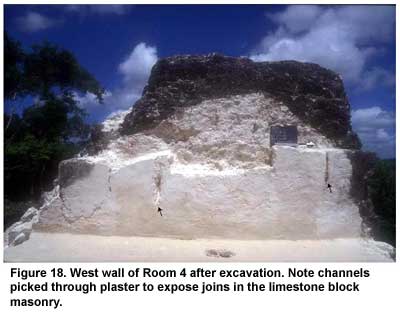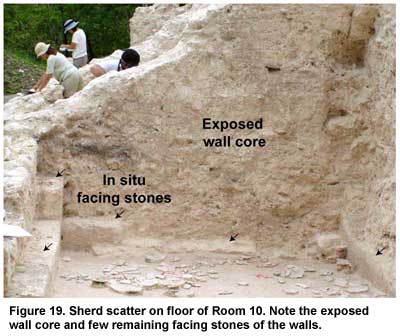
| FAMSI © 2005: Jason Yaeger |
||
Revisiting the Xunantunich Palace: The 2003 Excavations III. Dismantling and Filling the Flanking Rooms of the Lower Building The next modification to Str. A-11 involved the dismantling and filling of the four rooms that flanked the central room (Rooms 7, 8, 10, and 11). First, the blocks of the walls and corbel vault were pulled down by picking through their plastered surfaces along the joins between blocks and then removing the blocks (Figure 18, below, shows similar marks on the west wall of Room 4, in the upper building). In some walls, the facing stones were removed down to the level of the floor (Figure 19, below); in others, they were left to a height nearing the vault spring. Most of the blocks were apparently removed for use elsewhere, as we found few blocks in the fill of the rooms. During this dismantling process, large utilitarian vessels were broken in the central and eastern rooms, and their remains scattered across the floors of the rooms. In the far eastern room, the skeleton of a young adult (early 20s, Sherry Gibbs, personal communication, 2004) was resting on its side in a flexed position, head to the north. No grave goods accompanied the body, which sat on a bit of marl just above the floor of the room. Although a few large rocks lay above the skeleton, there was no evidence of a crypt or other burial architecture. It is plausible to interpret this individual as a sacrifice, but it is important to note that there is no direct evidence to support that interpretation. The doorways leading to these rooms were sealed with large limestone blocks (note blocked doorways in Figure 10 and Figure 11). Then the rooms were filled up with marl and some limestone rocks. At the top of this marl fill in Room 10, the Maya placed an offering of several red-slipped bowls. These vessels are unusual, in that most offerings at Xunantunich that use bowls incorporate Mount Maloney Black vessels. Red slipped vessels of Pine Ridge carbonate ware, like those in this deposit, are quite rare in Xunantunich and its hinterland. Sealing these two lateral rooms, the Maya eliminated architectural spaces associated with relatively private interactions between the ruler, members of the court, and some subjects. |
||
|
Text links to all pages at this site are available at the FAMSI INDEX |
||

